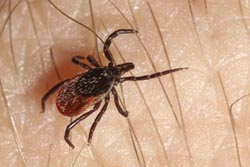Lab-on-a-chip system for Lyme disease diagnosis
LD is caused by the bacterium Borrelia burgdorferi. Left untreated the disease can result in serious symptoms such as arthritis, cardiac muscle infection and neuroborreliosis, inflammation of the central nervous system. The EU-backed 'Highly sensitive and specific low-cost lab-on-a-chip system for Lyme disease diagnosis' (HILYSENS) project was initiated to address diagnosis issues through the development of a portable, user-friendly, robust, Borrelia-specific multi-antigen assay in a microfluidic lab-on-a-chip (LOC) device. This should enable precise and reproducible detection of Borrelia antibodies in human blood serum for early diagnosis and monitoring of LD treatment progress. HILYSENS members achieved considerable success in their endeavours. LOC prototypes were manufactured on a large scale using ultraviolet (UV) embossing with a nickel master. Capillary forces were used to transport a sample and reagents to the detection chamber inside the LOC. To optimise the detection system, several antigens specific for Borrelia infections were produced and tested on infected human samples. Out of these, 16 were selected to detect different stages of Borrelia infection and results were validated using ELISA testing on human sera samples. The selected antigens were successfully immobilised on the chip surface. A fluorescence reader was built to enable detection through quantum dots coated with antibodies against human sera. The LOC prototype was tested on 50 LD patient samples in order to correlate with clinical diagnostic results. Further development in a post-project phase is being engaged to improve functional features and optimize sensitivity, specificity and reproducibility parameters with regard to LD detection. Small and medium-sized enterprises (SMEs) effectively conducted knowledge transfer through an Exploitation Agreement between the participant SMEs. Project outcomes have been disseminated through the project website(opens in new window) , posters, leaflets, slides and a public abstract to reach the scientific community, general public and industry. Socioeconomic costs of LD amount to around EUR 660 million annually. Early and accurate detection of childhood and adult LD will not only considerably reduce health care costs but also improve patient outcomes and quality of life. These innovative LOCs will also increase EU competitiveness in the global medical biosensor devices sector by becoming the standard diagnostic tool for LD. Moreover, this LOC can also be adapted for other diseases and bacterial-sensing applications.






